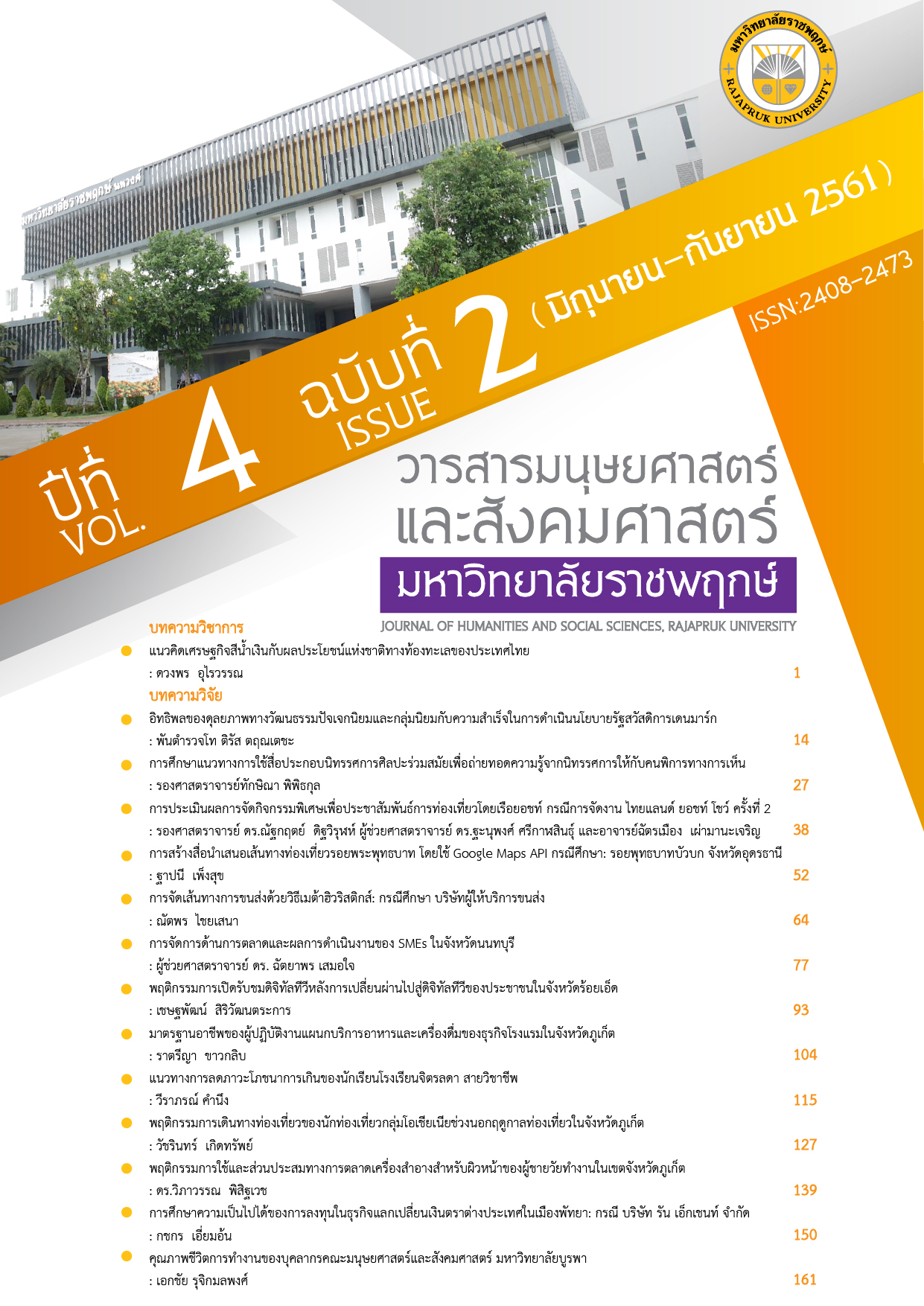Study Guidelines for Assistive Media Used in Contemporary Art Exhibitions for Giving People with Visual Impairment Means to Understand and Learn in Museum Exhibitions
Main Article Content
Abstract
This study is conducted with two objectives; 1) to study the problems and obstacles of the assistive media using in the contemporary art exhibitions for people with visual impairment and 2) to introduce the use of assistive media in the contemporary art exhibitions to the museums and contemporary art galleries in Thailand in order to distribute the knowledge among people with visual impairment. This study employs multiple sources of data collection covering literature reviews, online journals, observation, and interview with the museum experts and the museum visitors. The target group of this study consists of art museums, contemporary art galleries and the exhibitions in Thailand and overseas that involve with visually impaired audiences.
Research has found that in order to transmit the information of an exhibition to the visually impaired, media that relates to other senses than sight should accompany the exhibition, for instance through 1) Tactile Media: gaining information through one of the most basic senses that is not easily degradable. Tactile media is one of the media that allows the visually impaired to best visualize an object, especially if it is of similar size and texture. 2) Auditory Media: transmits audio from audio devices.
3) Olfactory Media: transmits the natural and environmental state of a material.
4) Visual Media (for those with partial sight): is media that transmits visual similarities to those who have problems seeing or are not totally blind, for example larger and clearer font sizes and information. Lastly 5) Activity and Interaction Media: is used in various ways to add channels of interaction. These various media can help to stimulate awareness and transmit various types of information in an effective way, and aid the visually impaired to understand the context and theory of an exhibition and to visualize it internally.
Article Details
References
สำนักงานคณะกรรมการการอุดมศึกษา. (2555). การช่วยเหลือและอำนวยความสะดวกอย่างสมเหตุสมผลและเทคโนโลยีสิ่งอำนวยความสะดวกสำหรับนักศึกษาพิการ. เอกสารประกอบการอบรมหลักสูตรการพัฒนาศักยภาพบุคลากรที่เกี่ยวข้องกับการจัดการศึกษาสำหรับคนพิการในระดับอุดมศึกษา. กรุงเทพฯ: สำนักงาน. ค้นเมื่อ 6 กุมภาพันธ์ 2560. จาก http://www.mua.go.th/users/des/information/Training%20for%20students %20with %20disabilities/Reasonable%20Accommo
วันเพ็ญ (นามสมมุติ). (5 สิงหาคม 2560). สัมภาษณ์. ผู้เข้าชมพิพิธภัณฑ์ซึ่งเป็นคนพิการทางการเห็น.
องค์อร วงษาลังการ. (2553). การใช้ตัวอักษรและสัญลักษณ์ในงานออกแบบนิเทศศิลป์เพื่อรองรับผู้พิการทางสายตาประเภทเห็นเลือนราง. วิทยานิพนธ์ปริญญาศิลปมหาบัณฑิต สาขาวิชาการออกแบบนิเทศศิลป์ บัณฑิตวิทยาลัย มหาวิทยาลัยศิลปากร. ค้นเมื่อ 9 สิงหาคม 2560. จาก http://www.thapra.lib.su.ac.th/thesis/showthesis_th.asp?id=0000005542
Hyungsook Kim. (2007). Art education and art museums: Visitors learning. The SNU Journal of Education Research, 17(6): 135 - 158. Retrieved September 18, 2015, from s-space.snu.ac.kr/bitstream/10371/70685/1/ vol17_6.pdf
Horley Dickey, M. (2017). Interview. Curator of Public Programmes. Tate Modern, London.
Office of The Higher Education Commission. (2012). Reasonable Accommodations and Assistive Technology Accommodating Students with Disabilities in Higher Education. Training Material of Human Resources Development Course Related to Educational Management for Disabilities in Higher Education. Retrieved February 6, 2017, from http://www.mua.go.th /users/des/information/Training%20for%20students%20with %20disabilities/Reasonable%20Accommo (in Thai)
Wanpen (Pseudonym). (August 5, 2017). Interview. Visually Impaired Visitor. (In Thai)
Saichai, K. (2017). Buddhism Art and Knowledge Management. Journal of Humanities and Social, Science, Rajapruk University, 3(1): 1-10. Retrieved April 20, 2018, from https://www.tci-thaijo.org/index.php/ rpu/article/view/112524/87647 (In Thai)
Wongsalangkarn, O. (2010). Application of typography and symbols in visual communication design for people with the visual disabilities; Low vision case. A Thesis for the Degree Master of Fine Arts. Department of Visual Communication Design Graduate School Silpakorn University. Retrieved August 9, 2017, from http://www.thapra.lib.su.ac.th/thesis/showthesis_th.asp? id=0000005542 (in Thai)

